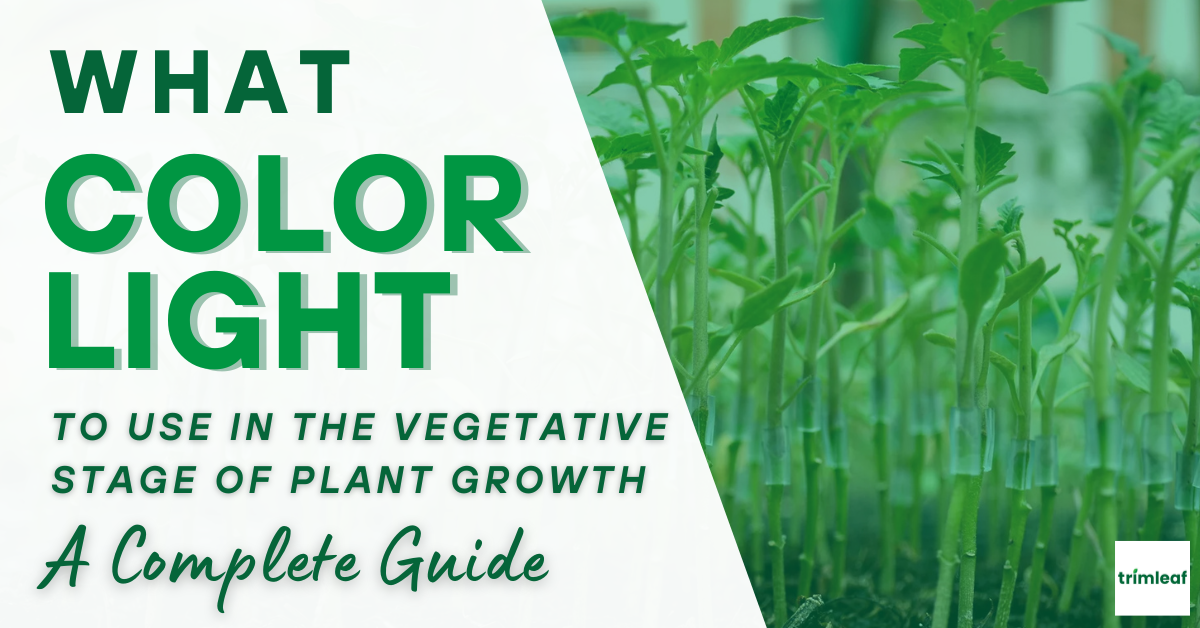
Indoor gardening is a rewarding experience, considering the benefits it brings to anyone looking to ramp up harvests.
But growing indoors comes with challenges, especially during the early stages of plant growth. After all, if you don’t get the early stages right, chances are, your plants won’t reach their full potential.
One of the critical factors here is the lighting your plants get. Understanding how light color influences your plants can make or break your indoor garden’s production, as not having the right light settings can produce weak and leggy plants. This holds, especially during the vegetative stage of plant growth.
For you to set the right tone for your plant's growth, let’s take a look at how lighting influences the early stages of plant growth.
Table of Contents
Understanding the Vegetative Stage and Light Needs
The vegetative phase of plant growth is critical, as this is when plants develop leaves, stems, and roots. The stored energy in your plants is used to develop a robust structure that ensures lush foliage and flowering or fruiting, depending on the plants.
Strong stems and a healthy root system ensure plants can absorb nutrients and light energy for plants to thrive.
Why Light Matters

Light is important to plants as this is the energy source needed for photosynthesis. During the vegetative stage, plants require light to produce chlorophyll to trigger photosynthesis.
Now, the color or spectrum of the light plays a critical role here.
In the vegetative stage, plants need the blue light spectrum to help stimulate photosynthesis. Vegatative grow lights also promotes phototropism, which allows plants to position themselves towards the light source.
Full Spectrum vs. Blue Light Only

One of the popular choices for grow lights now features full-spectrum coverage. Full-spectrum grow lights mimic natural sunlight and cover all stages of plant growth, having a mix of blue and red spectrum.
That considered, if you’re choosing between full-spectrum or sticking to blue spectrum, here’s what you should know:
Full Spectrum Lights
✅Full spectrum grow lights are best for growing plants that develop fruits and flowers
✅Allows you to tune the spectrum to meet the needs of the plant
✅Optimizes photosynthesis
✅Mimics the natural light cycle, helping plants adjust to day and night cycles
Blue Light Only
✅ Specifically optimized for vegetative growth and leaf development
✅ Promotes stronger stem growth and prevents leggy plants
✅ More energy-efficient when you only need vegetative growth
✅ Ideal for leafy greens and plants grown for foliage
Should You Add Red Light?
While Blue Light is the most crucial spectrum in vegetation,
Red Light is also used in the vegetative stage, especially in the latter part before flowers and fruits develop.
Adding a touch of red light lets you create natural lighting, similar to natural sunlight.
However, too much red light at this early stage can make your plants develop weak stems. If you are unsure about how to balance the two spectrums, it’s best to stick to blue light during the vegetative stage.
Balancing Distance, Intensity, and Duration
Aside from knowing what color spectrum to use, it’s also important to know the intensity, distance, and duration needed for your plants in the vegetative stage.
- Distance - Grow lights distance are higher with seedlings and gradually lowered as the plants start growing.
- Intensity - Depends on the grow light that you are using. High-intensity grow lights may need a higher position their brightness cannot be adjusted to the optimal levels.
- Duration - Seedlings need a longer duration and gradually shorten as they grow, mimicking the natural duration of sunlight as seasons pass.
Choosing the Right Grow Light for Your Plants
Now, that you know the importance of blue light in plant growth, it’s time to get a grasp of your choices for grow light.
The nice thing about blue lights is the options available. You get more options, compared to red grow lights.
LED Grow Lights
LED grow lights are a standard for many indoor gardens. They come in blue, red, and full spectrum options. One reason to consider LED grow lights is their energy efficiency, delivering higher intensities while consuming less power.
However, LED grow lights have a higher upfront cost, but the savings are a good trade-off.
Fluorescent Lights
Fluorescent grow lights are more affordable than LED grow lights and are ideal for smaller spaces. Like LED grow lights, they also emit low heat, which makes them ideal even when room space is limited.
However, fluorescent lights don't have a long lifespan and are not as efficient as LED grow lights.
Metal Halide Lights
Metal Halide grow lights are known for their higher intensities, which make them ideal for developing seedlings in larger spaces. With their high intensities, they can deliver strong intensities of blue spectrum for your plants.
However, due to their intensities, they are known for their high heat emission, which requires them to have sufficient space and cooling fans to manage temperatures.
Parting Thoughts
The early stage of plant growth needs a sufficient amount of blue light to develop. It’s crucial in triggering photosynthesis, to ensure that plants have a robust foundation in the roots and stems for lush foliage.
If you’re looking to get started with developing those greens, check out our selection of grow lights, which include vegetative grow lights. Check out also our buyer's guide, especially if you’re looking for full-spectrum coverage.
Frequently Asked Questions About Color Light for Vegetative Stage
- What is the vegetative stage of plant growth?
- The vegetative stage is the initial growth phase of a plant where it develops leaves, stems, and a strong root system.
- Why is blue light important for plant growth?
- Blue light is crucial for plant growth as it stimulates photosynthesis, promotes chlorophyll production, and encourages stem and leaf development.
- What are the benefits of using full-spectrum grow lights?
- Full-spectrum grow lights mimic natural sunlight, providing a balance of blue and red light. This versatility allows them to support both vegetative and flowering stages of plant growth.
- Can I use only blue light for my plants during the vegetative stage?
- Yes, you can use only blue light during the vegetative stage, especially for leafy greens and herbs. However, adding a small amount of red light can enhance growth and development.
- How important is light intensity for plant growth?
- Light intensity is crucial for plant growth. Insufficient light can lead to weak, leggy plants, while excessive light can cause stress and damage.
- How does the distance between the light source and plants affect growth?
- The distance between the light source and plants influences light intensity. As plants grow, the light source should be gradually raised to maintain optimal light exposure.
- What is the ideal light cycle for plants during the vegetative stage?
- A 16-18 hour light cycle is generally recommended for the vegetative stage. This mimics the long days of spring and summer, encouraging rapid growth.
- What are the advantages of LED grow lights?
- LED grow lights are energy-efficient, produce low heat, and come in various spectrums, including blue, red, and full-spectrum. They are a popular choice for indoor gardening.
- What are the drawbacks of fluorescent grow lights?
- While affordable and energy-efficient, fluorescent grow lights have a shorter lifespan compared to LED lights and may not provide the same level of light intensity.
- How can I prevent heat stress in plants under grow lights?
- To prevent heat stress, ensure proper ventilation and airflow around your plants. Consider using fans to circulate air and reduce the temperature. Additionally, monitor the temperature and humidity levels in your grow space to maintain optimal conditions.




